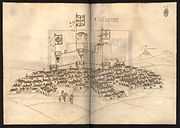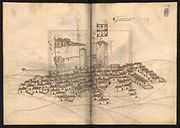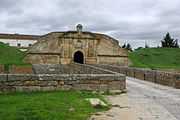Castle Fortress of Almeida
| Castle of Almeida (Castelo de Almeida) | |
| Praça de Almeida | |
| Castle (Castelo
Porta das Muralhas de Almeida.jpg) | |
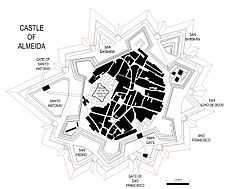 Plan of Almeida fortress village | |
| Named for: Almeida | |
| Country | |
|---|---|
| Region | Beira (Portugal) |
| Subregion | Beira Interior Norte Subregion |
| District | Beira Alte |
| Municipality | Almeida |
| Location | Almeida |
| - coordinates | 40°43′32.4″N 6°54′21.5″W / 40.725667°N 6.905972°WCoordinates: 40°43′32.4″N 6°54′21.5″W / 40.725667°N 6.905972°W |
| Architects | David Álvares[1] |
| Style | Vaubanesque Star fort |
| Material | Masonry |
| Founded | 1641 |
| Owner | Portuguese Republic |
| For public | Public |
| Management | Instituto Gestão do Patrimonio Arquitectónico e Arqueológico |
| Hours | Castle casemates, Daily, October to March, 9:00 a.m. to 12:30 p.m. & 2:00 p.m. to 5:00 p.m./ April to September, 10:00 a.m. to 12:30 p.m. & 2:00 p.m. to 5:30 p.m.[2] |
| Status | Property of Public Interest Imóvel de Interesse Público |
| SIPA Registration | No. IPA.00001382[3] |
| Wikimedia Commons: Muralhas da Praça de Almeida | |
Castelo de Almeida is a castle located in the village of Almeida[4] in the Beira Alta Province of north west Portugal. The castle was constructed here because of its position of great strategic significance[5] due to its close proximity to the border between Portugal and Spain. It is classified as a National Monument.[3] [6]
History
The settlements in this area of Portugal were strategically placed on hill tops and gave the local population excellent vantage points to detect any approach of would-be raider or aggressor and these fortified villages were important to the survival and protection of the local people. The first defence structures built in Almeida are thought to have been constructed by the Romans, but it is thought that there may have been early works here which the Roman's worked into there structures.
Moorish occupation
The Roman occupation of Almeida was followed by the Suevi and the Visigoths. The first recorded fortification constructed in the settlement were constructed by the Moorish Taifa of Badajoz who occupied the village until Christian conquest by Ferdinand I of León and Castilein 1039. Over the next 150 years the village alternated between the Muslims and Christians occupation. In 1190 the village and fortifications came in to the possession of a Portuguese Knight and nobleman by the name of Paio Guterres[7] who gave the village the name Almeidão.
The medieval castle
By 1217, document show that the castle at Almeida is one of several strong points that guard the border between Spain and Portugal. On the 8 November 1296[7] a royal charter was given for Almeida by King Dinis I who decreed that the castle should be rebuilt and expanded. Further strengthening and enlargements to the castle were instigated by King Ferdinand I in 1369. In 1372, Isabel the Illegitimate daughter of Ferdinand I married Alfonso, Count of Gijón and Noroña, who was the Illegitimate son of King Henry II of Castile. This marriage was one of the clauses of the peace treaty signed between Portugal and Castile in 1373, along with the castle and lands of Almeida been ceded to Castile.
War with Castile
In 1386 during a war with Castile, King John I of Portugal recaptured the castle and village of Almeida along with many other towns, many of which were delivered to John I by Portuguese nobles from the Castilian side and the stability of the Portuguese throne was permanently secured. During the reign of King Manuel I ordered the strengthening and enlargement of the castle's walls and fortifications. The works were carried out under the instruction of the architect Mateus Fernandes and were completed in 1508.
Book of Strongholds
Almeida Castle was included in a set of manuscripts formed into a book which contained drawings of all 56 castles located on the border between Portugal and Spain. The book, called the Book of Strongholds, had been ordered to be compiled by King Manuel I and was compiled between 1509 and 1510. The author was Duarte D'Armas, who was a squire of the royal house and a bachelor of canon law and apostolic notary, who held the office of Registrar of the Royal Library and the Torre do Tombo. he personally visited each castle and fortress for the purpose. There are two drawings of Almeida Castle in the book. a north elevation and a south elevation with both castle drawings bearing the personal standard of King Manuel I.
Portuguese Restoration War
João IV became king of Portugal on the first of December 1640. To consolidate and strengthen his throne the new king made several decisions to maintain his hold of the country. He created a Council of War to organize the countries security along with a Junta of the Frontiers. This Junta had the responsibility of reviewing and strengthening the existing fortresses near the border. One of the Junta's projects was the construction of the star fort at Almeida. This is the fortress that stands on the site today and it surrounded the previous medieval castle which stood here. The fortress was completed in 1641 and is a 12 pointed star shaped fortress. Responsibility for the supervision of the fortress works was carried out by the architect David Álvares.[1] The fortress was built in a Vaubanesque style, to which the French military engineer is believed to have personnel worked on,[8] during the castles final stages of completion.
During the period of the Seven Years' War the fortress was besieged by Spanish Forces for nine days between 16 and the 25 August 1762.[9] This action became known as the Siege of Almeida. The Spanish forces were commanded by the Count of Aranda who lead a major Spanish offensive to take control of Portugal. The northern pincer of this force crossed the border into Portugal from Galicia, whilst the southern arm crossed the frontier from the direction of Ciudad Rodrigo and was soon outside the fortress of Almeida. On the 25 August the Spanish took Almeida and advance west beyond Almeida towards Porto. This advance towards Porto was stalled due to the influx of 8,000 British troops and the Battle of Valencia de Alcántara, events which caused sever interference to the Spanish resources and supply line. The fortress was garrisoned by the Spanish and was held despite the set-backs. Almeida remained the only major fortress still held by Spain until the end of the war. Following the peace treaty agreed in Paris, Almeida was returned to Portugal in exchange for the return of Cuba and the Philippines to Spain which had previous been in the hands of the British.
1808 occupation during the Peninsular War
Following Napoleon's French Imperial forces's brutal repression of the Spanish insurrection in Madrid known as the Dos de Mayo, the Emperor triggering the Peninsular War by ordering a force of 4,000 troops with sixteen cannon across the border to occupy the fortress of Almeida,[10] which despite early French invasion of the country, was still in the hands of the Portuguese. From the fortress, Napoleon ordered that his general Junot[10] should closely observe the cities of Valladolid, Salamanca and Ciudad Rodrigo. On the 24 May 1808[10] the first body of troops under the command of General Louis-Henri Loison [10] marched on to Almedia arriving and occupying the fortress on the 5 June.[10]
Description
The fortress seen today is arranged on an irregular hexagonal plan and consists of six polygon, irregular and uneven sized bastions which are connected by curtain walls and forming a perimeter of 1.5 miles (2.4 km) and forms a 12 pointed star shaped fortress with six triangular shaped ravelins .[1] The fortress perimeter is completed with a moat and road with a covered terrace. The three ravelins on the north elevation are constructed on a flat masonry parapet wall topped with escarpment walls in stone. At each angled corner of the northern ravelins there is a cylindrical watchtower with a dome roofs. These ravelins are topped with ramped platforms for canons and launching mortars placements. The three ravelins on the southern elevation have flat masonry parapet walls which are crowned with ramparts of earthworks and like the northern ravelins are topped with ramped platforms for canons and launching mortars placements. These six bastions are called São Francisco, São João de Deus, Santa Bárbara, de Nossa Senhora das Brotas ou do Trem and Santo António e São Pedro. The São João de Deus ravelin has integrated large bunkers built into its interior.
Gateway
To access the fortress the main gate is located at the south east curtain wall between Santo António e São Pedro and São Francisco and features a set of two long tunnel gateways separated by a bridge over the dry moat. the outer arched tunnel is called Puerta de la muralla the inside tunnel gateway is called Porta São Francisco. The facade of this gate features an arched entrance with double Doric columns either side. The columns are topped by a semi-circular shaped pediment. below the pediment and above the entrance there is a heraldic blazon or crest of arms.
Gallery
|
References
- ↑ 1.0 1.1 1.2 "Walls of the Plaza de Almeida - Almeida Fortress". Section Heading, Architect - Builder - Author. reference to the 1641 architect. Institute for Housing and Urban Renewal Ministry of Agriculture, Sea, Environment and Spatial Planning © 2014. Retrieved 10 July 2014.
- ↑ St Louis - Coordinating Author, Regis (2009). Portugal - Lonely planet guide. Reference to opening times of Castle casamates (7th ed.) (lonely planet Publishers). p. 381. ISBN 9781741790153.
- ↑ 3.0 3.1 "Walls of the Plaza de Almeida - Almeida Fortress". SIPA Registration No. IPA.00001382 Description of the castle and its function, history, construction. Institute for Housing and Urban Renewal Ministry of Agriculture, Sea, Environment and Spatial Planning © 2014. Retrieved 9 July 2014.
- ↑ Portuguese civilian survey: Sheet 18B Almeida. Publishers: Instituto Geográfico Português (Portugal Civilian Survey). Scale:1:50,000. ISBN 9728867115
- ↑ Evans, David (2004). Portugal - Cadogan guides. Reference to the strategic importance (New Holland Publishers). p. 200. ISBN 1860111262.
- ↑ St Louis - Coordinating Author, Regis (2009). Portugal - Lonely planet guide. Reference to the Castle's designation as a National Monument (7th ed.) (lonely planet Publishers). p. 381. ISBN 9781741790153.
- ↑ 7.0 7.1 "Walls of the Plaza de Almeida - Almeida Fortress". Section chronological timeline. Institute for Housing and Urban Renewal Ministry of Agriculture, Sea, Environment and Spatial Planning © 2014. Retrieved 9 July 2014.
- ↑ Evans, David (2004). Portugal - Cadogan guides. Reference to Sébastien Le Prestre de Vauban participation in the construction (New Holland Publishers). p. 200. ISBN 1860111262.
- ↑ Jaques, Tony (2007). Dictionary of Battles and Sieges: A Guide to 8,500 Battles from Antiquity through the Twenty-first Century, Volume 1, A to E. reference to the nine day siege and its outcome (Greenwood). p. 37. ISBN 978 0313335372.
- ↑ 10.0 10.1 10.2 10.3 10.4 Horward, Donald D. (1984). Napoleon and Iberia - The Twin Sieges of Ciudad Rodrigo and Almeida, 1810. Reference occupation of the Fortress of Almedia by Loison (Greenhill Books). pp. 3/4. ISBN 9781853671838.
| Wikimedia Commons has media related to Praça-forte de Almeida. |
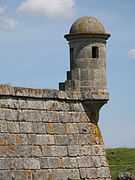
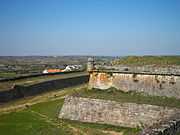
.jpg)
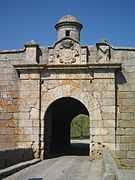
.jpg)
